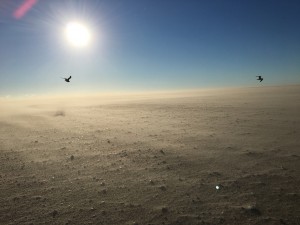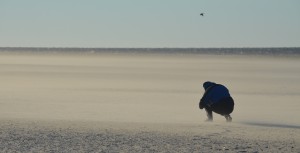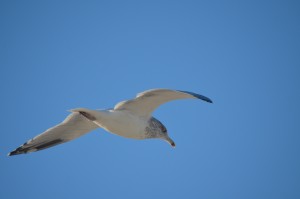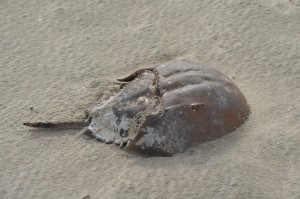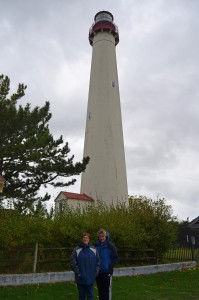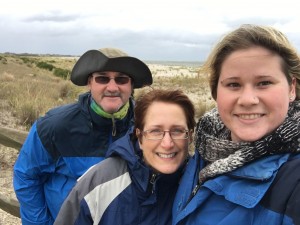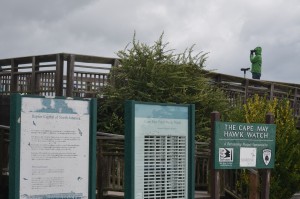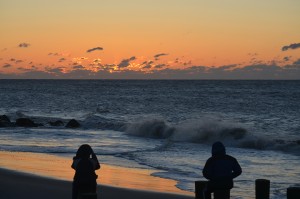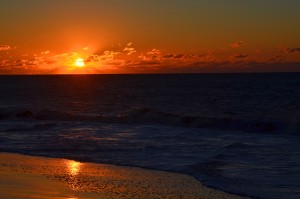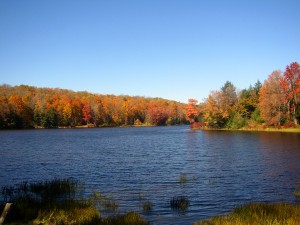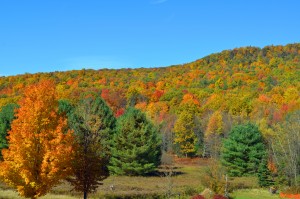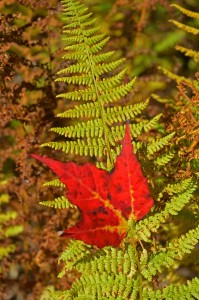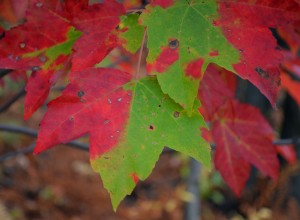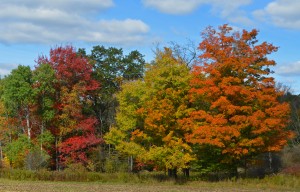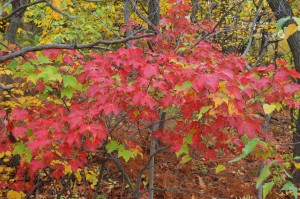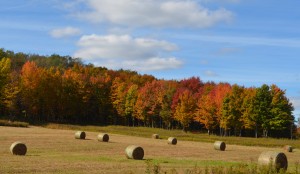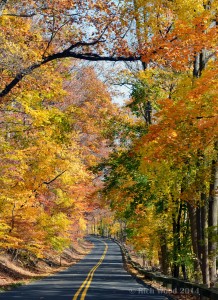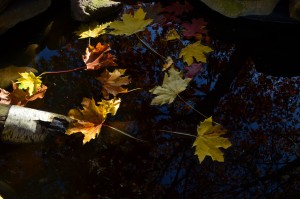With winds whipping at 30+ MPH, the grains of sand stung our faces as we slowly trudged across the beach to snap a few photos of the waves crashing in. The ocean seemed angry, constantly throwing 4-6 footers at the eroding beach. Other than a few a Ring-billed Gulls and small flocks of Sanderlings battling the strong gusts, Theresa, Darby and I were the only brave (crazy) visitors to this barren stretch of “salt water desert.” We were visiting Cape May Point for our annual fall trip to this southern NJ area known for its fantastic fall migration of birds. However, our timing was a bit off, since the 78 degree sunny, warm weather they were experiencing for the past 2 weeks had given way to a big, cold front, with several hours of rain and pounding gale force winds. Not the best conditions for outdoor activities, especially birding.
Strong winds transform the usual mild beach into a blasting sand storm, as Darby tries to capture the conditions with some creative photos
A young Ring-billed Gull struggles in the gusty wind and a dead horseshoe crab begins to get covered by the blowing sand
 Cape May Point is one of the best fall birding spots in the U.S. Birders from all of the east coast flock (pun intended) to this southern tip of New Jersey every autumn in hopes of seeing huge flights of raptors, song birds and seabirds. Why here? Most of the birds that are migrating south from eastern Canada and New England use the coastline in their journey south, kind of like a 3-D road map. The iconic symbol in the landscape here is the historic Cape May Lighthouse, in Cape May Point SP. The famous Cape May Hawk Watch is also located here, where volunteers count thousands of migrating birds of prey each year, from August through November. Cape May Point is the last tip of land the birds can use (rest and feed) before having to take the long flight over the Delaware Bay. So thousands of birds are “funneled” right over this peninsula. If conditions are right, thousands of birds may fly right over your head, from dawn to dusk. The final destination for some species may only be as far as Florida, while many others continue to Central and South America to spend the winter. Remember, when it’s winter up here in North America, it’s summer in South America! But, during our weekend, the birds had a very tough time of it.
Cape May Point is one of the best fall birding spots in the U.S. Birders from all of the east coast flock (pun intended) to this southern tip of New Jersey every autumn in hopes of seeing huge flights of raptors, song birds and seabirds. Why here? Most of the birds that are migrating south from eastern Canada and New England use the coastline in their journey south, kind of like a 3-D road map. The iconic symbol in the landscape here is the historic Cape May Lighthouse, in Cape May Point SP. The famous Cape May Hawk Watch is also located here, where volunteers count thousands of migrating birds of prey each year, from August through November. Cape May Point is the last tip of land the birds can use (rest and feed) before having to take the long flight over the Delaware Bay. So thousands of birds are “funneled” right over this peninsula. If conditions are right, thousands of birds may fly right over your head, from dawn to dusk. The final destination for some species may only be as far as Florida, while many others continue to Central and South America to spend the winter. Remember, when it’s winter up here in North America, it’s summer in South America! But, during our weekend, the birds had a very tough time of it.
The best conditions for seeing migrating birds at Cape May Point is with winds from the north or northwest. During our visit, the winds were directly out of the south, and strong! The birds we did manage to see, were struggling to fly into a brutal headwind. Despite the challenging conditions, we got some good looks at Sharp-shinned Hawks, American Kestrels, Merlins, Osprey, Bald Eagles, Turkey Vultures, Yellow-rumped and Palm Warblers, many gulls, Sanderlings, Black Skimmers, Caspian Terns and thousands of swallows.
Sanderlings (top photo) and Caspian Terns (bottom photo) hunker down in the wind.
Because of the tough, outdoor weather, we spent some time in beautiful Cape May, sampling some of the local eating/drinking establishments, an awesome fudge shop (they shouldn’t give out free samples), and once again, walking the beach through sand blasting winds, in search of the perfect sunrise photos. Cape May in late October is like Forest Gump’s box of chocolates, “you never know what you gonna get!”
